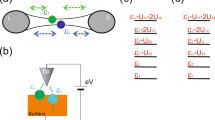Abstract
The method developed by one of the authors is generalized to include paramagnetic impurities in order to explain zero bias tunneling anomalies. The self-energy of the electrons is supposed to be a local function in space; nonlocal or assisted tunneling effects are beyond the scope of the present theory. The tunneling current is expressed in terms of the local density of states at the barrier which in turn is given in terms of the life-time of the conduction electrons. The change of the local density of states depends on the positions of the impurities relative to the metal-oxide interface. This dependence is thoroughly investigated.
Résumé
La méthode développée par l’un des auteurs est généralisée en l’étendant sur les impuretés paramagnétiques pour l’explication des anomalies de l’effet tunnel a zero bias. La self-énergie des électrons est supposée d’être une fonction locale dans l’espace en sorte d’exclure de la théorie présente des effets tunnel non-locaux ou assistés. Le courant tunnel est exprimé en fonction locale de la densité d’états a la barrière, qui, a son tour, est une fonction de la durée de vie des électrons de conduction. Le changement local de la densité d’états dépend des positions rélatives de l’impureté et de l’interface métal-oxyde. Cette dépendance est étudiée en détail.
Zusammenfassung
Es wird die von einem der Verfasser entwickelte Methode so verallgemeinert, daß sie auch paramagnetische Verunreinigungen umfaßt, um anomale Tunneleffekte mit Zero Bias zu erklären. Die Selbstenergie der Elektronen wird als eine im Raum lokale Funktion aufgefaßt; nicht-lokale oder assistierte Tunneleffekte werden von der vorliegenden Theorie nicht erfaßt. Der Tunnelstrom wird in Abhängigkeit von der lokalen Zustandsdichte an der Barriere ausgedrückt, die ihrerseits von der Lebensdauer der Leitungselektronen abhängt. Die Veränderung der Zustandsdichte wird durch die Lage der Verunreinigungen relativ zum Metall-Oxyd-Übergang bestimmt. Diese Abhängigkeit wird gründlich untersucht.
Similar content being viewed by others
References
Wyatt, A. F. G.: Phys. Rev. Letters13, 401 (1964).
Rowell, J. M., andL. Y. L. Shen: Phys. Rev. Letters17, 15 (1966).
Anderson, P. W.: Phys. Rev. Letters17, 95 (1966).
Appelbaum, J.: Phys. Rev. Letters17, 91 (1966); Phys. Rev.154, 633 (1967).
Suhl, H.: Lectures on the International “Enrico Fermi School” on Physics. Varenna (1966).
Zawadowski, A.: Proceedings of the 10th International Conference on Low Temperature Physics, 1966 (Moscow). Vol. IV. p. 336.
Wyatt, A. F. G., andD. J. Lythall: Phys. Letters25 A, 541 (1967).
Mezei, F.: Phys. Letters25 A, 534 (1967).
Hall, R. N., J. H. Racette, andH. Ehrenreich: Phys. Rev. Letters4, 456 (1960).
e. g.Logan, R. A., andJ. M. Rowell: Phys. Rev. Letters13, 404 (1964);B. M. Vul, E. J. Zavaritskaya, andN. V. Zavaritskii: Fiz. Tverd. Tela8, 888 (1966). [Translation: Soviet Phys. Solid State8, 710 (1966).]
Mahan, G. D., andC. D. Duke: Phys. Rev.149, 705 (1966).
Duke, C. B., S. D. Silverstein, andAlan J. Bennett: Phys. Rev. Letters19, 315 (1967).
Mahan, G. D.: Lecture on the Summer School “Advanced Study Institute on Tunneling Phenomena in Solids” June 19–31, 1967 Risö, Denmark.
Jaklevic, R. C., andJ. Lambe: Phys. Rev. Letters17, 1139 (1966).
Scalapino, D. J., andS. M. Marcus: Phys. Rev. Letters18, 459 (1967).
Sólyom, J., andA. Zawadowski: Report of the Central Research Institute for Physics KFKI 14 (1966, unpublished).
Appelbaum, J. A., J. C. Phillips, andG. Tzouras: Phys. Rev.160, 554 (1967).
Anderson, P. W.: Phys. Rev. Letters18, 1049 (1967).
Bardeen, J.: Phys. Rev. Letters6, 57 (1961) and9, 147 (1962).
Zawadowski, A.: Phys. Rev.163, 341 (1967).
Sólyom, J., andA. Zawadowski: Lecture on the International Conference on Magnetism, 1967, Boston.
Kondo, J.: Prog. Theor. Phys. (Japan)32, 37 (1964).
Abrikosov, A. A., L. P. Gorkov, andI. E. Dzyaloshinski: Quantum Field Theory in Statistical Physics (Prentice Hall, Englewood Cliffs, New Jersey, 1963).
Nagaoka, Y.: Phys. Rev.138, A 1112 (1965).
Schrieffer, J. R., D. J. Scalapino, andJ. W. Wilkins: Phys. Rev. Letters10, 336 (1963).
Author information
Authors and Affiliations
Rights and permissions
About this article
Cite this article
Sólyom, J., Zawadowski, A. Theory of zero bias anomalies due to paramagnetic impurities. Phys kondens Materie 7, 325–341 (1968). https://doi.org/10.1007/BF02422778
Received:
Issue Date:
DOI: https://doi.org/10.1007/BF02422778




